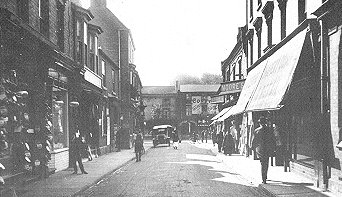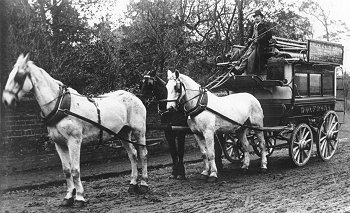Part Three
|
Daniel and Helen and family lived in Cannon Street; Thomas, his
wife Margaret and daughter, Mary lived in King Street; so did
David, his wife, Ann, and daughters, Fanny and Mary; and John
with his wife, Mary, but they didn't have any children. After
Daniel's sons, Thomas and Daniel were married, they also lived
in the vicinity.
|
|

Cross Street, Willenhall. From an old
postcard. |
Thomas and family first lived in Russell Street and then moved to
Raglan Street; Daniel and family lived in King Street, but after the
death of his grandmother, he moved to New Railway Street. The lock
business seems to dominate the Worrall's family history, Making
locks was a hard job and they worked long hours. It is difficult to
imagine how they lived in their small houses with such large
families, and the kind of transport they would have.
|
|
When Daniel and Helen were beginning their married life together
progress had been made in public transport with the beginning of
railways. However, passenger-carrying vehicles were rare before the
seventeenth century. Before that people either walked, climbed above
a cart or rode a horse. Roads were often poor as illustrated below. |
|
From Roman times to the eighteenth century little improvement was
made in road building. Roads had ruts and potholes which were
repaired by filling with soil, which soon washed away. Thomas
Telford (1787-1834) and John Macadam (1756-1836 were responsible for
building much better roads. The use of passenger carrying vehicles
only gradually increased, and they did not become common until the
latter half of the eighteenth century, which would be the time when
John and Mary Worrall set up home in Willenhall. |

An old dirt-track road. |
|

An old coach. |
This was also the time when, according to the records, there were in
1770, 148 locksmiths in Willenhall, 134 in Wolverhampton, and 8 in
Bilston. Some transport would have been necessary for the Heads of
the lock firms to transport their locks on a Saturday night to the
factors in Wolverhampton or Birmingham, and then return home with
orders for the following week or so. |
|
During the nineteenth century horse drawn vehicles flourished
and different types were available in an almost bewildering
variety. However, the London to Birmingham Railway Line opened
in 1837, operating from the new Euston station. It halved the
journey time between the cities to less than six hours, but it
had taken 20,000 labourers to build.
|

A horse-drawn bus. Courtesy of Lawson
Cartwright. |

|
|

|
| Return to
the previous page |
|
Proceed to
the next page |
|